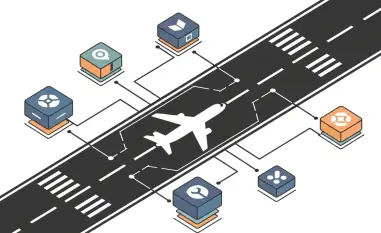Introduction: A Nation Exposed to Cyber Threats
Imagine a scenario where the digital backbone of the United States—its critical infrastructure, healthcare systems, and transportation networks—stands vulnerable to relentless cyberattacks from foreign adversaries, all because a key legislative safeguard has lapsed due to a government shutdown. This is the stark reality facing the nation as the Cybersecurity Information Sharing Act of 2015 (CISA 2015) expires amid congressional gridlock over appropriations bills. With cyber threats from nations like China and Russia escalating, the absence of this pivotal law, which enabled vital threat information sharing between private companies and federal agencies, has left U.S. cyber defenses critically weakened. The timing could not be worse, as agencies tasked with safeguarding the nation operate with constrained resources, amplifying concerns across industries about the security of essential systems.
This report delves into the profound implications of the CISA 2015 lapse, exploring its historical role in bolstering national cybersecurity and the immediate risks posed by its expiration. It examines the political and operational challenges hindering effective cyber defenses, alongside the broader regulatory landscape shaping these efforts. By analyzing current trends and expert insights, the report aims to provide a comprehensive understanding of how this legislative gap impacts both public and private sectors, while offering a glimpse into potential strategies for resilience in an increasingly digital and hostile world.
Understanding the Role of CISA 2015 in US Cybersecurity
The Cybersecurity Information Sharing Act of 2015, commonly referred to as CISA 2015, emerged as a cornerstone of U.S. cybersecurity strategy by fostering a collaborative environment for sharing cyber threat intelligence. Enacted to bridge the gap between private enterprises and the federal government, the legislation enabled companies to disclose vulnerabilities and attack data without fear of legal repercussions, a mechanism that proved essential for rapid response to emerging threats. Administered through key entities like the Department of Homeland Security (DHS) and the Cybersecurity and Infrastructure Security Agency (CISA), the law targeted critical sectors such as healthcare, energy, and transportation, where disruptions could have catastrophic consequences.
A significant achievement of CISA 2015 was the establishment of liability protections, which built trust among private organizations wary of sharing sensitive information. This trust catalyzed public-private partnerships, allowing for the creation of robust threat detection and mitigation frameworks. By facilitating real-time intelligence exchange, the act empowered federal agencies to issue timely alerts and coordinate defenses against sophisticated cyberattacks, often orchestrated by state-sponsored actors targeting national infrastructure.
The impact of these efforts extended beyond immediate threat response, influencing long-term cybersecurity policies across industries. Sectors reliant on digital infrastructure benefited from standardized protocols for data sharing, which enhanced overall resilience. As a result, CISA 2015 became a linchpin in safeguarding the nation’s digital ecosystem, underscoring the importance of sustained legislative support for such initiatives in maintaining a proactive stance against evolving cyber risks.
Current Crisis: CISA Lapse Amid Government Shutdown
Triggers and Timing of the Shutdown
The government shutdown, initiated on October 1 due to Congress’s inability to pass necessary appropriations bills, has precipitated a dire situation for national cybersecurity. This political impasse, rooted in partisan disagreements over budgetary priorities, has directly led to the expiration of CISA 2015, a law integral to the nation’s defense against digital threats. Without renewed funding or legislative action, the mechanisms that once facilitated seamless coordination between sectors have ground to a halt, exposing systemic weaknesses at a critical juncture.
The timing of this shutdown exacerbates the crisis, as global cyber threats have reached unprecedented levels of sophistication. Adversarial nations are increasingly targeting U.S. systems with advanced tactics, seeking to exploit any lapse in vigilance. The convergence of political dysfunction and heightened external risks has created a perfect storm, leaving policymakers and industry leaders scrambling to address the fallout from this legislative void.
Immediate Fallout and Vulnerability Assessment
The expiration of CISA 2015 has stripped away liability protections that encouraged private companies to share threat intelligence with federal agencies, a change with immediate repercussions. Industry analysts predict a significant drop in voluntary data sharing, as organizations now face potential legal and financial risks for disclosing vulnerabilities. This reluctance undermines the collective ability to detect and counteract cyberattacks, creating blind spots in national security frameworks.
Compounding the issue, the shutdown has severely limited resources at DHS and CISA, the very agencies tasked with coordinating cyber defenses. With reduced staffing and operational capacity, response times to emerging threats are expected to slow, heightening the risk of breaches in critical infrastructure. Experts warn that sectors like energy and finance, already prime targets for hackers, could face devastating disruptions if coordinated intelligence sharing remains impaired.
Insights from cybersecurity professionals paint a grim picture of the immediate dangers. Many emphasize that the absence of structured collaboration could lead to preventable incidents, as delayed threat identification allows attackers to exploit vulnerabilities unchecked. The consensus is clear: without swift resolution, the nation’s digital defenses stand on precarious ground, with potential consequences that could ripple across the economy and public safety.
Challenges in Maintaining Cyber Defenses Without CISA 2015
The lapse of CISA 2015 has disrupted well-established channels for threat coordination, leaving both government and private entities struggling to adapt. These channels, painstakingly developed over years, were vital for disseminating actionable intelligence and orchestrating unified responses to cyber incidents. Their breakdown threatens to fragment efforts at a time when cohesion is paramount, particularly as attackers leverage advanced techniques to penetrate defenses.
Trust between public and private sectors, a hard-won achievement of the original legislation, now faces erosion due to the uncertainty surrounding data-sharing repercussions. Companies, wary of litigation or reputational damage, may opt to withhold critical information, a decision that could prove costly in the face of escalating threats. This growing disconnect hampers the ability to anticipate and mitigate attacks, exposing the nation to risks that were once manageable through collaborative vigilance.
Interim measures, such as ad-hoc agreements or voluntary frameworks, have been proposed to bridge the gap, though their effectiveness remains questionable amid political volatility. Sustaining cooperation without a clear legal mandate poses logistical and strategic challenges, as stakeholders grapple with inconsistent guidelines and limited federal oversight. Until a legislative resolution is reached, the cybersecurity community must navigate uncharted territory, balancing immediate protective needs against the backdrop of systemic uncertainty.
Regulatory and Political Landscape Impacting Cybersecurity
The government shutdown and subsequent lapse of CISA 2015 highlight the fragility of cybersecurity frameworks tied to political processes. National security, often considered above partisan divides, has been compromised by delays in legislative action, revealing a troubling dependency on stable governance for maintaining digital defenses. This situation raises questions about the sustainability of linking critical laws to annual budgetary cycles prone to disruption.
Compliance with cybersecurity mandates, previously incentivized by CISA 2015, played a pivotal role in fostering collaboration across sectors. Its absence not only stalls ongoing IT security projects but also deters new initiatives, as organizations await clarity on legal protections. Industry stakeholders have issued urgent calls for bipartisan support to reinstate the law, stressing that prolonged delays could embolden adversaries seeking to exploit current vulnerabilities.
The broader regulatory environment further complicates the landscape, as political gridlock affects not just CISA 2015 but also related cybersecurity policies. The resulting uncertainty undermines confidence in federal leadership on digital threats, prompting some private entities to seek alternative, less coordinated solutions. This fragmentation risks weakening the nation’s overall defensive posture, emphasizing the need for a more insulated approach to cybersecurity governance that can withstand political upheavals.
Future Outlook: Building Resilient Cyber Defenses
Looking ahead, the growing reliance on legislative mechanisms to sustain cybersecurity collaboration underscores the need for more robust, independent systems. The lapse of CISA 2015 serves as a cautionary tale, illustrating how easily political disruptions can derail essential protections. Developing frameworks that operate beyond the constraints of annual funding disputes could prevent similar crises, ensuring continuity in threat response capabilities.
Emerging technologies, such as artificial intelligence and quantum computing, are reshaping the cyber threat landscape, adding layers of complexity to defense strategies. These advancements, while offering innovative tools for protection, also equip adversaries with unprecedented means to attack. Anticipating and countering such risks will require adaptive policies and investments in cutting-edge research, potentially spanning from the current year to 2027, to maintain a technological edge.
Global cyber threats and shifting political dynamics further influence long-term security planning, necessitating international cooperation and domestic resolve. Renewal efforts for CISA 2015, expected to gain momentum post-shutdown, must be accompanied by broader reforms to fortify resilience. Trends toward decentralized threat intelligence platforms and enhanced private sector autonomy may also shape the future, offering pathways to mitigate risks even in the face of legislative uncertainty.
Conclusion: Charting a Path Forward
Reflecting on the insights gathered, the expiration of CISA 2015 during the government shutdown exposed significant vulnerabilities in U.S. cyber defenses, disrupting vital threat-sharing mechanisms at a perilous moment. The immediate risks to critical infrastructure and national security underscored the urgency of addressing this legislative gap. Industry leaders and experts united in their concern, highlighting how the loss of trust and coordination amplified exposure to sophisticated attacks.
Moving forward, actionable steps emerged as a priority, with a strong push for Congress to expedite bipartisan efforts to reinstate and strengthen CISA 2015. Beyond immediate renewal, the crisis pointed to the necessity of designing cybersecurity frameworks insulated from political volatility, perhaps through dedicated funding or autonomous oversight bodies. Investing in technological innovation and fostering international alliances also surfaced as critical strategies to stay ahead of evolving threats. Ultimately, this challenging period served as a catalyst for reimagining how the nation safeguards its digital frontiers, ensuring that resilience becomes the cornerstone of future efforts.













